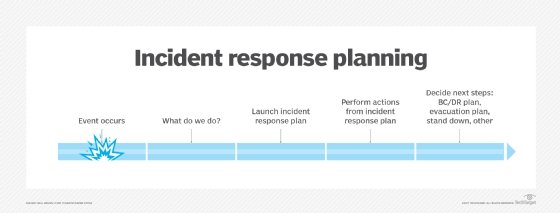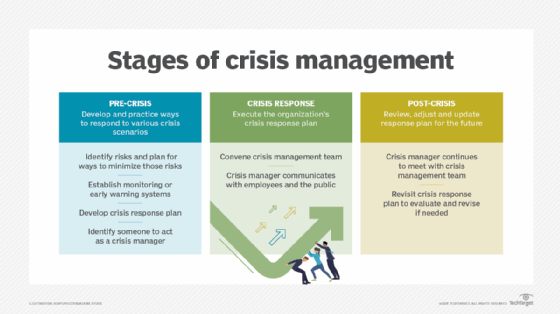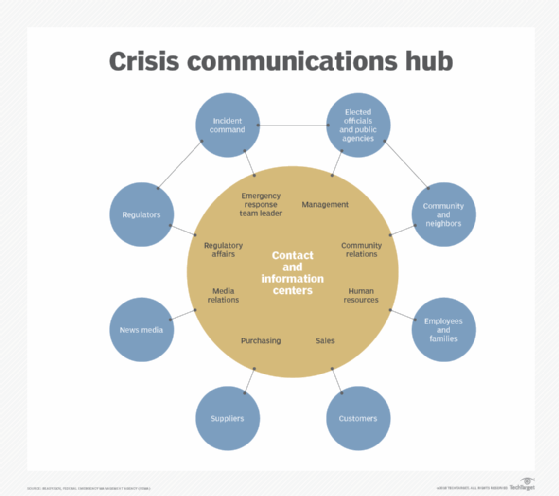crisis communication
What is crisis communication?
Crisis communication is a strategic approach to corresponding with people and organizations during a disruptive event. When a crisis occurs, proactive, quick, detailed communication is critical; a crisis communication strategy, plan and tools can ensure such communication happens.
The need for crisis communication
Every business should have a communication plan that documents the protocol for distributing information in a time of intense difficulty or danger. Because a business's reputation is at stake in those situations, it's important to impart information to the public -- and other stakeholders -- to ease concerns and counteract rumors or false information.

For better planning and to ensure proper crisis communication, an organization should assume that it will experience a crisis at some point. Examples of events that warrant crisis management planning include on-site incidents with injury or property damage, natural disasters such as earthquakes, public incidents such as a terror attack or pandemic, as well as cybersecurity incidents including ransomware exploits and data breaches -- especially those that involve the disclosure of personally identifiable information. As certain crises such as cyber attacks have become more frequent, crisis communication increasingly is seen as a key element of business continuity and disaster recovery.
What are the 5 stages of a crisis?
A typical crisis includes five phases or stages:
Phase 1: Pre-crisis. Strictly speaking, the pre-crisis phase is not part of the crisis itself. Rather, it involves planning and education that can help an organization avoid or mitigate a crisis. During this phase, the business must monitor emerging risks, anticipate possible crises, educate interested parties about possible risks and suggest actions to take in the event of a crisis. The business also reaches out to necessary authorities and groups for collaboration and future help. It creates potential messages and communication systems and tests them, and identifies the crisis communication team that will communicate during the event.
Phase 2: Initial. During the initial phase, the crisis has started, and the organization begins communicating. Because it can be a confusing, intense period, the organization should seek to provide clear, accurate direction; provide resources for more information; and calm fears, if necessary. Even if there isn't a lot of information to provide, crisis communication is still important and should reassure people that the organization is working on a solution.
Phase 3: Maintenance. In this phase, the organization provides crisis updates and details any ongoing risks. It also gathers feedback from anyone affected by the crisis, corrects misinformation, and continues to assess and respond to the situation.
Phase 4: Resolution. When the crisis reaches the resolution phase, the situation has effectively ended, but recovery and communication continues. The organization should communicate how it is recovering and rebuilding, and provide more detailed information about how the crisis happened. The resolution phase is a good time to remind people how to be prepared in the event of another crisis.
Phase 5: Evaluation. During crisis evaluation, two-way communication is important. The organization evaluates and assesses how the response went and how it could be improved in future. An after-action report comprehensively documents the crisis and response. The crisis communication plan is also reviewed and updated as needed.
Any business that experiences a crisis must ensure communications keep flowing during every phase of the crisis. Continuous, clear communication minimizes confusion and can help to reduce chaos during crisis management and response.

How is crisis communication done well?
Good crisis communication requires a comprehensive crisis communication plan. The plan should specify who will communicate the message and what communication channels will be used to deliver it. The organization must ensure consistency of its message so as not to confuse the intended audiences and cause harm to its reputation and brand.
Communicators must be ready to answer questions from a variety of groups, including employees, customers and the media. Management should be kept informed about the questions being asked and the nature of social media posts about the crisis.
Engaging an outside public relations firm can help a crisis-hit business interact with the media. However, if the organization resolves the crisis quickly enough, taking that step might not be necessary.

What makes a useful crisis communication plan?
A crisis communication plan is a comprehensive document that includes useful, timely details about the following:
- Audiences, or the people who should receive information about the crisis.
- Contact information for each audience.
- Messaging.
- Communication mediums.
Potential audiences for crisis communication include customers, employees, media, suppliers, company management, investors, and authorities such as law enforcement, government agencies or regulatory officials.
The contact information for key members of these audiences must be easily accessible during a crisis. It should also be comprehensive and include stakeholder names, phone numbers, addresses and email addresses. These details allow responders to share important information about the crisis with the right people, at the right time. It's important to update contact lists frequently to prevent communication gaps and delays.
Pre-written messages are also an important feature of a useful crisis communication plan. When a crisis hits an organization, the pressure of dealing with it can make it hard to craft appropriate messages with the right words and tone. Mistakes in these areas can create confusion among stakeholders, increase chaos and even exacerbate the impact of the crisis.
That's why it's best to create message scripts or templates in advance, when the business is not overwhelmed by a crisis. Each template should include sections to explain what happened or is happening, how the crisis affects stakeholders, what actions the stakeholders must take, and what actions the organization is taking to deal with the crisis. If the organization performs risk assessments to assess the possible impact of future crises, results of the assessments should inform the pre-written message templates.
Another key feature that distinguishes a usable crisis communication plan is a glossary of terms relevant to the crisis. This will ensure the language used in all communications remains consistent and does not create confusion or problems during crisis response.
In modern times, organizations have many options when it comes to communicating crisis information. It's best to include multiple options in the communication plan to maximize the reach of the messaging. For example, social media is a quick way to reach hundreds or thousands of people. However, it shouldn't be the only method, because not everyone uses social media. Similarly, some people prefer to get updates via text messaging instead of phone calls. A good crisis communication plan should cover such considerations.
Finally, an optimal communication plan is one that is consistently reviewed, tested and updated. Regular reviews can reveal flaws and weaknesses. The company can then address those to strengthen the plan and increase preparedness for a future crisis.
Important tools and resources for crisis communication
When a disruptive event occurs, it's useful to have a variety of tools and resources that can help with crisis communication and mitigation. Examples include the following:
- Communication systems or devices such as phones and fax machines.
- Copies of emergency response, business continuity and crisis communication plans.
- Active social media accounts to post crisis updates.
- Site and building diagrams to facilitate quick evacuations.
- Forms for documenting events for later analyses and investigations.
- Message boards to share updates with employees.
- Webmaster tools or personnel to make quick website updates.
A call tree, also known as a phone tree, is also useful to have in the toolkit. In a manual call tree, one person calls a designated contact, then that person calls a designated contact, and so on. If the next person on the list cannot be reached, the caller continues with the next contact so that the chain does not break. This method leverages human contact and interaction, but there can be issues if people affected by the crisis cannot be reached.
Automated call tree software is also available to minimize the calling effort and time required. The software makes simultaneous calls to numerous people, helping to reduce or eliminate possible breaks in a call tree and to reach and inform the maximum number of people.
Learn how to build a strong crisis communication team and how to implement a communication plan. Explore the roles and responsibilities of a crisis management team and 12 key points that a disaster recovery plan checklist must include.






